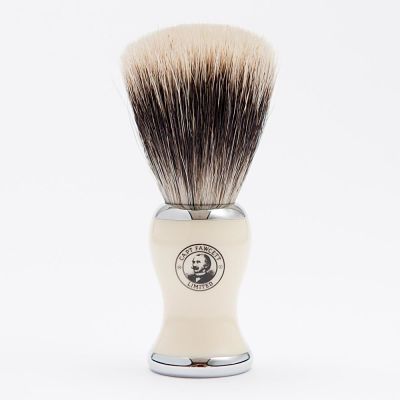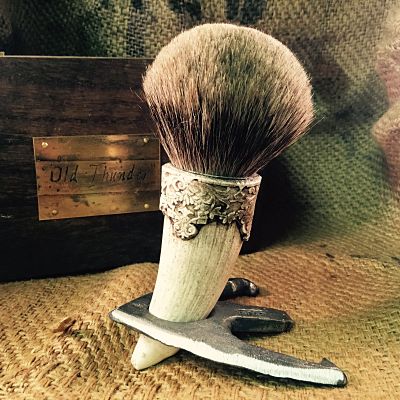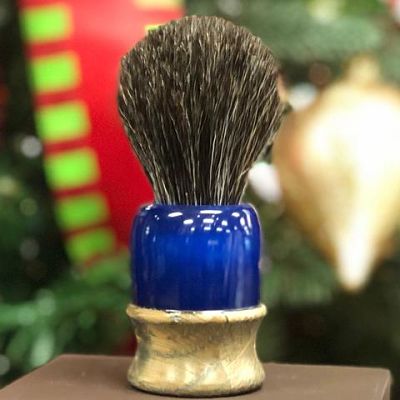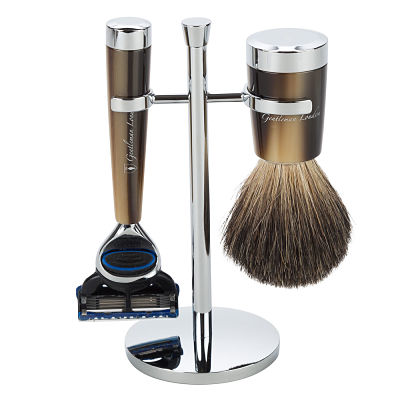 If there is one piece of grooming equipment that has been neglected by collectors over the past 50 years it has to be the humble shaving brush. Besides being fun to collect, shaving brushes are critical for achieving an outstanding shave.
If there is one piece of grooming equipment that has been neglected by collectors over the past 50 years it has to be the humble shaving brush. Besides being fun to collect, shaving brushes are critical for achieving an outstanding shave.Every morning millions of men around the world face the mirror to remove their facial hair. Shaving has developed into what it is over thousands of years, but the best part is, that in contemporary times, there is much less blood spilled in the process. This is due to the many advancements in the equipment used for this task. Razors have become much less hostile, with the invention of triple and quad bladed razors as well as electric razors. For those who like to shave wet, the lathering soaps work well and are easy to use. So why not simply use the electric razor?
The main reason being that a closer shave is usually achieved with wet shaving, but electric razors continually improve and will perhaps surpass the wet shave.
First, the shaving brush infuses your shaving cream or soap with water, creating a richer lather than you could create with your fingers. Second, when you are applying the lather to your face, you are gently exfoliating your skin and removing dry cells so that your face is healthy and soft. Finally, a shaving brush helps to lift and soften the facial hair so that you can get the closest shave possible. The problem is, many men who do possess one of these essential grooming tools use them incorrectly – something that does not just impair the quality of your shave but can also cause damage to the brush itself.


Shaving brushes are not that tricky to use. To get the most out of the brush dip the tip in warm water, ensuring it is thoroughly wet, flick or shake off any excess water and dip it into your shaving cream, coating the tip as evenly as possible. Apply to the face using a gentle back and forth motion. Most men use a rough circular motions at this stage but while this might be good at creating a lather in record time it is bad news for the life of the brush, because it weakens the bristles at its centre.
The higher the quality of the shaving brush, the higher the lather and water load that it can carry, making the shave quicker. The user does not have to continually get more soap from the shaving mug. The more water the shaving brush holds the richer and moister the lather will be. The thicker the lather, the easier the shave, as there is less drag on the razor and the razor has no chance of missing the facial bristles. The greatest benefit from shaving brushes is the tendency to soften and lift the facial bristles, which cannot be achieved by applying the lather by hand. In fact, when applying the lather with the hand, the bristles are flattened, making it more difficult to shave quickly.
 Another mistake made by many men is to leave the brush the right way up after shaving. This is a recipe for disaster since it prevents the bristles from drying properly and can cause the base of the hairs to rot. Instead, invest in a good drip stand (many brushes come with one) and allow the brush to dry naturally while upside down. Make sure that the air can circulate around the brush while it is drying. All this is especially important with top quality badger-hair brushes, where prolonged dampness can damage the bristles. And in case you are wondering, badger hair does make the best brushes, primarily because of its softness, toughness and remarkable ability to retain water.
Another mistake made by many men is to leave the brush the right way up after shaving. This is a recipe for disaster since it prevents the bristles from drying properly and can cause the base of the hairs to rot. Instead, invest in a good drip stand (many brushes come with one) and allow the brush to dry naturally while upside down. Make sure that the air can circulate around the brush while it is drying. All this is especially important with top quality badger-hair brushes, where prolonged dampness can damage the bristles. And in case you are wondering, badger hair does make the best brushes, primarily because of its softness, toughness and remarkable ability to retain water.A man’s face is a personal space and most men will develop a technique that suits them best. If one chooses to use the wet method for shaving, purchasing a high quality shaving brush will make the process easier. Traditional shaving brushes were invented in France and only badger hair was used. This type of brush is still available, however the price is very high for the top of the range, silver tip badger hair shaving brush. For most applications modern synthetic blended shaving brushes will do the trick. There is also a need to purchase a soap mug, in order to produce the lather, although many use shaving lotions and gels that come in a pressure pack.
